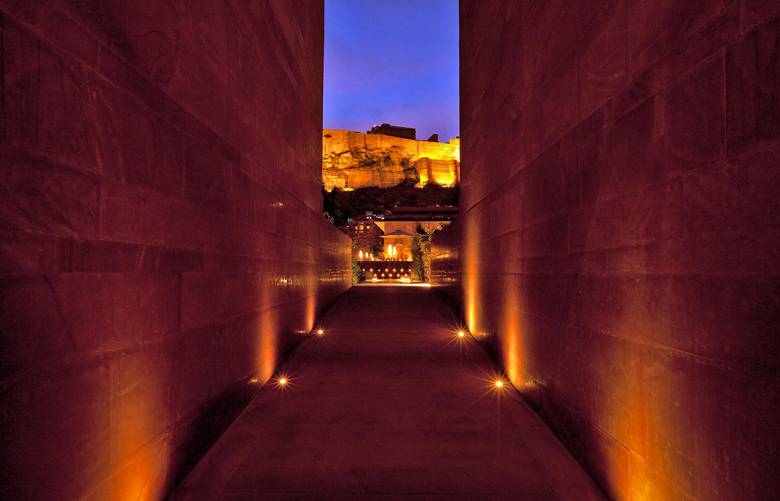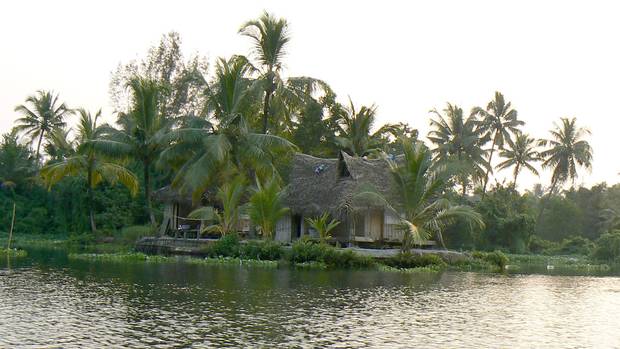After the type of harrowing overnight bus ride that can only be experienced in India, I find myself in the Thar desert standing on a wide, sandy, largely abandoned (by Indian standards) road in the city of Jaisalmer.
Roughly 138 kilometres away from the eastern border of Pakistan, Jaisalmer is a time capsule to a medieval trading era founded on sandstone buildings and camel trains. Ahead of us looms Jaisalmer Fort, the huge golden citadel that is a lasting remnant of the city's glorious former era.
My friends and I try calling our guest house numerous times on our flighty Indian cellphones. But receiving no answer, we, at a loss for direction, do the most sensible thing we can, and sit down on the red sand at the side of the road, leaning on our backpacks. It begins to rain; fat, singular drops evolve to sheets. I pull my hood up, rub my eyes, and tilt my face to look up at grey clouds. It's 7 a.m.
Eventually, we are picked up and driven to our rooms inside the walls of the fort. Our ruminating prickliness from the sleepless bus ride begins to wear off as we sit on the rooftop to watch the haze hang in the damp morning. Eggs are served by a jovial Muslim man named Fattan who has exquisite thick silver rings on his fingers, sapphire eyes and coiffed hair. Little Johnny, the house manager, sits and chats with us while we slowly wake up.
Johnny Rocket can be encouraged to stand with a series of clicks and a gentle flicking of his rope.
Kylee Pedersen for The Globe and Mail
We had spent 12 hours on an uncomfortable bus not only to see Jaisalmer's remarkable UNESCO sites, but also to explore the surrounding Thar desert from the back of a camel. Locals run one-night to two-week treks, and Little Johnny organized a two-night trip for the three of us leaving the next day.
After a drowsy breakfast of eggs and chai tea, we climbed into the back of an old Jeep Bolero with worn leather seats and no glass in its windows. We head northwest toward the Pakistan border with Little Johnny driving and bobbing along to the soundtrack of ABBA's greatest hits. The desert expands around us, vacant of much human activity except for the odd shepherd with his herd, low-standing constellations of homes, and clusters of methodically spinning windmills.
After two hours we pull off the main paved road onto a sandy path that knits itself through low-hanging and sporadically spaced desert foliage. Little Johnny stops at a dry riverbed and, as we step out, we are immediately embraced by a man of average height with an exceedingly above-average smile. Sporting dishevelled, windblown hair and traditional Muslim robes, Matar will be our guide. He is sweaty but smells sweet and his hairy forearms wrap around all of our bags at once.
We're led to a picnic blanket laid in sand of the riverbed under the shade of a tree, near three fuzzy camels that have strings of beads tied around their neck. Matar introduces us to them in the order of biggest to smallest – "Michael Jackson, Johnny Rocket and Harry Potter," he says proudly. Unfazed by our presence, the camels chew their cud in the midday heat.
Matar then makes fresh rotis over an open fire, which we use to scoop up plate after plate of curry. Full, we all recline in the sand and at Matar's suggestion have a nap to thwart the hottest part of the day.
Before we climb onto our camels, the group's gear and our small backpacks (stuffed with a change of clothes and long underwear; in February, temperatures can fall to 8 C at night) must be packed onto the animals. Matar has brought four blankets, two cases of water, a sack of flour, a smaller sack of chai, a sack of vegetables, and a couple of small tin pots, plates and glasses. It all fits seamlessly into leather side bags that hang over the animal's humps. Once the camels are outfitted, Matar motions us to climb aboard.
With a series of clicks and a gentle flicking of the rope, Matar encourages my mount – Johnny Rocket – to stand. I fiercely hold on to the front and back of my saddle to brace myself against the forward rocking motion before I regain my posture and find myself very high up. Our journey, marked by a song from Matar, begins.
Throughout the afternoon our caravan steadfastly treads West through the gentle slopes of the desert, stopping once in an isolated village of 60 for the camels to have what would be their final drink of water for the next three days. They share the trough with a herd of worried, parched goats, who take turns quickly sipping. Beyond the goats is a young boy who is playing with a homemade car on a string in the sand, and with him an even littler girl with soft, sun-browned cheeks, who darts amongst the goats and watches us in tight-lipped silence.
The land is quiet and the windmills slowly disappear as we roam through shrubs, trees and small flocks of cows and sheep, whose bells are the only sound. There is no visible trail, nor any particularly unique landmarks, yet Matar ambles on with the definitive movements of one who has made this trek many times. The gently rising, mushroom-coloured slopes go on as far as the eye can see and, each time we reach the top of one, new glades of white dunes fabricate on the horizon, like gleaming sandbars in an ocean of dry-shrub desert terrain.
Jaisalmer Fort, the huge golden citadel that is a lasting remnant of the city’s glorious former era.
Kylee Pedersen for The Globe and Mail
We pass under the shade of lone khejri trees, and glide by stoic cacti blooming with small pink flowers. In the silence my thoughts appear and disappear. I think about the smoothness of the camel's footsteps, and the slight warm breeze that grazes my face. I am grateful for the time I have to observe the intricacies of life here in this ancient and weathered landscape. The sun is tender and rosy, and Matar irregularly whistles or murmurs songs as I watch Johnny Rocket's feet step over narrow paths of ants.
That night, while Matar unsaddled the camels at our campsite, he told us to hike to the highest point of the dunes and watch the sun go down. The rippled sand swelled out beneath us like honey, as we sat in awe watching the orange orb sink further and further before it disappeared into the haze.
Matar has hobbled the camels, and occasionally we hear them rustle nearby while they nibble on desert grasses. He has made us a simple and delicious meal out of his minimal supplies. We sip chai and feast on freshly made rotis and enticingly spicy chickpea and cabbage curry.
"My life is here," says Matar that night as we eat by the light of the fire under the rising moon.
He was born in a Muslim village east of Jaisalmer, and was first introduced to camel herding by his father. "Only for one day!" he exclaims when I ask him if he went to school as a child. On his first day, at age 11, he misbehaved and was punished, and he told his mother that he would not be going back. Instead, he chose camels.
He says that he trained Michael Jackson, Johnny Rocket and Harry Potter from birth, but that they are owned by his boss, who has a herd of about 40 camels and employs eight other guides. "It is my dream to own my own camels one day."
An alleyway in Jaisalmer. The ancient city remains in good repair, despite the odd rubble pile of sandstone bricks.
Kylee Pedersen for The Globe and Mail
Matar refills our cups with hot chai. The cool night breeze is refreshing and carries no sound as it osculates past my ears and over my sun-bleached face. The fire burns low as we talk. Matar tells us about his children, and how he hopes they will go to school instead of ending up in the camel business like him.
We ask him about the history of the relationship between the Hindus and Muslims in the area, specifically since the current border between India and Pakistan was drawn in 1947. "But that was then," Matar says after he describes the vicious wars of the past. "There is not as much fighting now."
Everyone is ready to turn in, and Matar retreats to his own blanket on the sand near his camels. We lie on our backs and look at the sky. I think about where I am on a map. I have never been in such an isolated spot, and I can feel the miles of silent desert pressing in. I think about how our group is at the complete mercy of Matar, his navigational skills, his chai and his three lethargic camels, and I feel oddly at peace. I zip up the neck of my sweater and drift into sleep.
In the middle of the night I am startled awake by the distant howling of a desert dog. The clouds have melted and left a clear canvas of charcoal sky, where the stars dangle overhead. It is the most brilliant view I've ever seen.
Special to The Globe and Mail
Caravan shadows in the Thar desert.
Kylee Pedersen for The Globe and Mail

